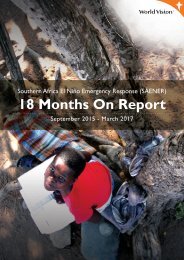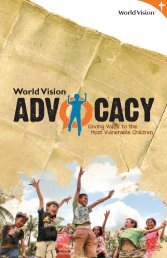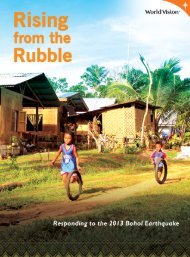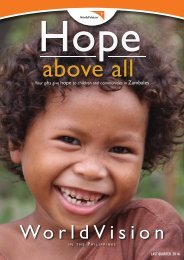INTER-AGENCY LIVELIHOOD ASSESSMENT - ARUA DISTRICT NORTHERN UGANDA GOAL
You also want an ePaper? Increase the reach of your titles
YUMPU automatically turns print PDFs into web optimized ePapers that Google loves.
KEY FINDINGS<br />
• The majority of the refugees rely on food assistance for their livelihood. In total, 58% are not<br />
participating in any economic activities, while 24% are engaged in farming activities by renting<br />
out land from the host communities. Meanwhile, 75% of the host communities depend on<br />
agricultural production as their primary economic activity, and 10% are involved in petty trade.<br />
Most people lack access to capital to expand businesses.<br />
• Food scarcity among the refugees and the host communities are driving prices of essential food<br />
items. Both communities have resulted in reducing meals and relying on less expensive foods to<br />
cope with the situation.<br />
• Refugees are mainly concerned about the reduction in the quantity of food distributed by<br />
World Food Programme (WFP) while the host communities are particularly worried about the<br />
scarcity of food in the markets causing inflation of prices of staple food such as cassava floor<br />
which doubled in price since December 2016.<br />
• Though the markets in the refugee and host community settlements are functional and<br />
providing the essential household items, there are few economic activities undertaken in<br />
comparison to their potential. Cash injection through cash-based programming is needed to<br />
spur growth.<br />
• Both the host communities and refugees are mainly relying on firewood for cooking, creating<br />
competition and pressure on this shared resource.<br />
• In total, 81% of the refugees and 79% of the host communities stated they are already<br />
concerned about the availability of fuel.<br />
• Only 4% of refugees and 5% of host communities are using fuel-efficient stoves (Lorena)<br />
• Most of the refugees and host communities (44% and 51% respectively) only have a primary<br />
level of education with 25% of the refugees and 6% host communities being illiterate/semiliterate.<br />
• Most employment opportunities accessible to the majority is mainly casual labour for 0 to 2<br />
days per week earning an income of between 0 to 10,000 UGX.<br />
• Most people are unskilled and unable to take advantage of economic activities on offer. The<br />
skills most demanded of men were building, followed by brick laying. Meanwhile, for women,<br />
the skills demanded were hairdressing followed by tailoring.<br />
• Savings groups were identified as the most available and preferred lenders of money at 32%,<br />
followed by friends and relatives at 23% and 21% respectively. Commercial banks and MFIs<br />
were least accessible to communities with only 1% of the respondents benefiting from their<br />
loans.<br />
BACKGROUND<br />
The South Sudan conflict started in December 2013 which initially was an “internal clash” and<br />
confined to Juba, the capital city of South Sudan. This internal clash turned into a full blown conflict<br />
which later spread to the regional cities of Bor and Malakal in Upper Nile region. The internal clash<br />
was as a result of the power struggle within the main political party, Sudan People’s Liberation<br />
Movement (SPLM) which led to the displacement of thousands of people, loss of lives and destruction<br />
of properties. The majority of the civilians were initially displaced into Internally Displaced Persons<br />
(IDP’s) camps, but later many fled to neighbouring countries of Kenya, Sudan, Ethiopia and Uganda.










